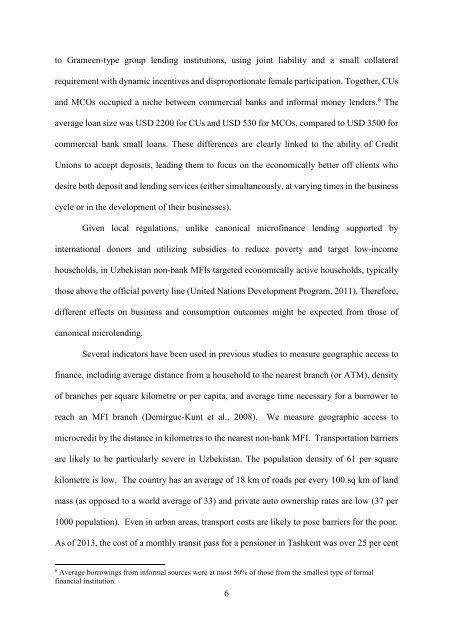The Importance of Geographic Access for the Impact of Microfinance
n?u=RePEc:htr:hcecon:445&r=cwa
n?u=RePEc:htr:hcecon:445&r=cwa
You also want an ePaper? Increase the reach of your titles
YUMPU automatically turns print PDFs into web optimized ePapers that Google loves.
to Grameen-type group lending institutions, using joint liability and a small collateral<br />
requirement with dynamic incentives and disproportionate female participation. Toge<strong>the</strong>r, CUs<br />
and MCOs occupied a niche between commercial banks and in<strong>for</strong>mal money lenders. 6 <strong>The</strong><br />
average loan size was USD 2200 <strong>for</strong> CUs and USD 530 <strong>for</strong> MCOs, compared to USD 3500 <strong>for</strong><br />
commercial bank small loans. <strong>The</strong>se differences are clearly linked to <strong>the</strong> ability <strong>of</strong> Credit<br />
Unions to accept deposits, leading <strong>the</strong>m to focus on <strong>the</strong> economically better <strong>of</strong>f clients who<br />
desire both deposit and lending services (ei<strong>the</strong>r simultaneously, at varying times in <strong>the</strong> business<br />
cycle or in <strong>the</strong> development <strong>of</strong> <strong>the</strong>ir businesses).<br />
Given local regulations, unlike canonical micr<strong>of</strong>inance lending supported by<br />
international donors and utilizing subsidies to reduce poverty and target low-income<br />
households, in Uzbekistan non-bank MFIs targeted economically active households, typically<br />
those above <strong>the</strong> <strong>of</strong>ficial poverty line (United Nations Development Program, 2011). <strong>The</strong>re<strong>for</strong>e,<br />
different effects on business and consumption outcomes might be expected from those <strong>of</strong><br />
canonical microlending.<br />
Several indicators have been used in previous studies to measure geographic access to<br />
finance, including average distance from a household to <strong>the</strong> nearest branch (or ATM), density<br />
<strong>of</strong> branches per square kilometre or per capita, and average time necessary <strong>for</strong> a borrower to<br />
reach an MFI branch (Demirguc-Kunt et al., 2008). We measure geographic access to<br />
microcredit by <strong>the</strong> distance in kilometres to <strong>the</strong> nearest non-bank MFI. Transportation barriers<br />
are likely to be particularly severe in Uzbekistan. <strong>The</strong> population density <strong>of</strong> 61 per square<br />
kilometre is low. <strong>The</strong> country has an average <strong>of</strong> 18 km <strong>of</strong> roads per every 100 sq km <strong>of</strong> land<br />
mass (as opposed to a world average <strong>of</strong> 33) and private auto ownership rates are low (37 per<br />
1000 population). Even in urban areas, transport costs are likely to pose barriers <strong>for</strong> <strong>the</strong> poor.<br />
As <strong>of</strong> 2013, <strong>the</strong> cost <strong>of</strong> a monthly transit pass <strong>for</strong> a pensioner in Tashkent was over 25 per cent<br />
6<br />
Average borrowings from in<strong>for</strong>mal sources were at most 50% <strong>of</strong> those from <strong>the</strong> smallest type <strong>of</strong> <strong>for</strong>mal<br />
financial institution.<br />
6


